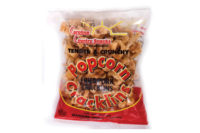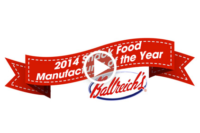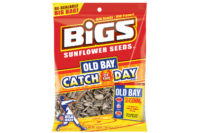Hues of Old and New
Hues of Old and New
The non-chocolate candy category is being driven by both sides of the spectrum—nostalgic favorites and novelty innovations.
It’s a colorful
bunch, the non-chocolate confections of the world, and so despite the fact
that total category sales were flat to slightly down last year, it remains
a bright spot in a retailer’s candy palette.
Diet candy was the clear sub-category winner in
non-chocolate for 2004—dollar sales were up nearly 36 percent last
year over the previous year, according to Information Resources Inc.
Sugar-free products were particularly popular with diabetics and low-carb
dieters last year, especially with improved flavoring and sugar substitute
innovation—both of which continue strong even in the early months of
2005. For example, the sugar-free sweetener xylitol is being touted as
“good for teeth,” and can now be found in a growing number of
candy and gum items.
Licorice was up slightly in dollar sales and unit
sales, which category experts attribute to the popularity of nostalgic
items, as well as to the “no-fat” benefit of the candy, which
manufacturers have heavily promoted. New and sour flavors have also been a
positive factor with younger licorice fans.
In seasonal candy, consumers had a love affair with
Valentine non-chocolate offerings last year. This holiday sub-segment
enjoyed nearly a six percent increase in dollar sales last year, according
to IRI.
Imperatives
Non-chocolate candy really emphasizes the fun side of
the market thanks to its rainbow assortment and focus on kids and the kid
in all of us (nostalgic candies). Unlike chocolate, which is typically a
more serious and savored indulgence (and one that must be merchandised and
enjoyed with certain handling and temperature considerations),
non-chocolate treats can drum up images of a carnival, the circus, the
movies. It’s a more transportable, take-along type of candy, and
therefore, can be seen as having more impulse appeal at retail.
Consumers
Non-chocolate consumers can be anyone, of course, but
currently, the market is focusing on kids today who have literally grown up
with novelty/interactive candy (members of that sub-segment are about 10
years old), as well as teens and adults who have memories of a favorite
non-chocolate item from when they were younger. With teens and young
adults, ‘80s nostalgia candy items are making a comeback; young
parents are happy to treat their own children with the candies they once
enjoyed as kids, perhaps as an excuse to enjoy them all over again. And
older adults, particularly baby boomers and their senior parents, are
gravitating toward nostalgic packaging.
Adjacencies
Mints and other non-chocolate “portables”
packed in small take-along tins and other convenient packaging are on the
rise in coffeehouses and specialty shops. Not wanting coffee breath or food
breath is a strong motivation for consumers to carry along mints and tiny
hard candies wherever they go. Fresh breath has become a professional
asset. Mass retailers have an opportunity to really capitalize on this
trend by cross-merchandising these treats near other specialty items such
as coffee, wine, cheeses, etc. Counter displays are a no-brainer. These
items are space friendly and highly impulsive.
Non-chocolate candy colors also make for a beautiful
bouquet—literally. Forward-thinking retailers are merchandising jelly
beans, lollipops, and other assorted candies in the floral department,
where arrangements can either include candy items or be purchased alongside
floral and balloon gifts.
Outlook
Non-chocolate candy is expected to see better days of
growth in the near future. While the novelty of novelty candy has worn off
a bit, the constant evolution of pleasing kids with candy/toy treats
certainly has not. Experts guess that how the product is shot or delivered
into the mouth will be the next novelty innovation.
As for adults, the non-chocolate segment is aiming to
please them, too, although in a more subtle way. The breath category
continues to rise and surprise consumers with the latest innovations in
sugar substitutes and nutrient additives. Hand-to-mouth convenience,
pop-tops and portability will continue to lead packaging trends.
Nostalgic trends abound throughout the category, as
spice flavors of home and hearth—cinnamon, nutmeg, pumpkin—are
expected to be on the up and up in 2005. Non-chocolate has become a more
upscale proposition. It may be reflected in the price, as in the case of
nostalgic tins that feature retro candy or in upscale mints with packaging
to match.
| 2004 Non-Chocolate Sales by Selected Segments | ||||
| Segment | $ Sales(in millions) | % Changevs. Year Ago | Unit sales(in millions) | % Changevs. Year Ago |
| Diet Candy | $257.5 | +35.8% | 160.2 | +37.7% |
| Hard Sugar Candy/Pkg and Roll Candy | $285.9 | -9.0% | 210.0 | -10.4% |
| Licorice Box/Bag > 3.5 oz. | $153.3 | +2.1% | 105.6 | +1.6% |
| Non-Chocolate Chewy Candy | $642.9 | -3.8% | 573.8 | -5.2% |
| Novelty Non-Chocolate Candy | $237.3 | -7.8% | 248.3 | -4.6% |
| Specialty Nut/Coconut Candy | $73.3 | -1.5% | 77.6 | -4.9% |
| *In food, drug and mass merchandisers, excluding Wal-Mart Source: Information Resources Inc. |
||||
Merchandising Musts
Divide and color.
Non-chocolate candy is a big, colorful sea, and while the colors and variety contribute greatly to customer attraction, they can also confuse and frustrate if department distinctions aren’t made. Kids’ candy—typically novelty-type candy, gummies, sours—needs to be clearly segregated from more generic or adult non-chocolate candy (hard candy, licorice, chewy candy, etc.), just as diet candy needs to be housed in its own section. Retailers are encouraged to use color creativity wherever possible. Bulk certainly lends itself to clever rainbow configurations, but category distinctions should be made first.
Non-chocolate candy is a big, colorful sea, and while the colors and variety contribute greatly to customer attraction, they can also confuse and frustrate if department distinctions aren’t made. Kids’ candy—typically novelty-type candy, gummies, sours—needs to be clearly segregated from more generic or adult non-chocolate candy (hard candy, licorice, chewy candy, etc.), just as diet candy needs to be housed in its own section. Retailers are encouraged to use color creativity wherever possible. Bulk certainly lends itself to clever rainbow configurations, but category distinctions should be made first.
Urge urgency.
Limited edition candies are not just for the chocoholics. There are jelly- bean type candies and other boxed treats that have come out with special edition flavors for years now—typically summer offerings that include such tastes as buttered popcorn, cotton candy, lemonade, etc. Retailers should highlight these items using either manufacturer displays or on their own terms, with creative endcaps of picnic treats, beach snacks, etc. Limited editions have been proven to capture incremental sales. Consumers will still buy their standard candies, but will then add on with those they know are in limited supply. Tropical flavors are especially on the rise currently. Limited edition candies are proving to be a fantastic R&D ground for manufacturers; retailers that can stick close to that can reap sales gains.
Limited edition candies are not just for the chocoholics. There are jelly- bean type candies and other boxed treats that have come out with special edition flavors for years now—typically summer offerings that include such tastes as buttered popcorn, cotton candy, lemonade, etc. Retailers should highlight these items using either manufacturer displays or on their own terms, with creative endcaps of picnic treats, beach snacks, etc. Limited editions have been proven to capture incremental sales. Consumers will still buy their standard candies, but will then add on with those they know are in limited supply. Tropical flavors are especially on the rise currently. Limited edition candies are proving to be a fantastic R&D ground for manufacturers; retailers that can stick close to that can reap sales gains.
Looking for a reprint of this article?
From high-res PDFs to custom plaques, order your copy today!








